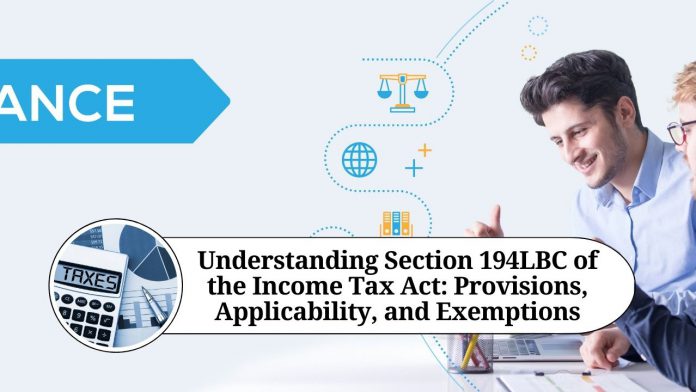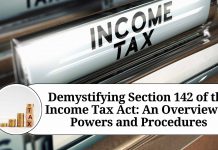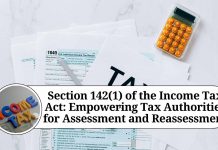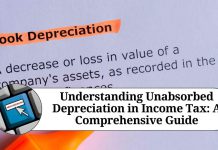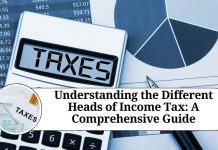Section 194LBC of the Income Tax Act is a provision that deals with the taxation of income distributed by a specified entity to its unit holders. The section was introduced in the Finance Act 2016 and applies to income distributed on or after 1 June 2016. In this blog, we will discuss the provisions of Section 194LBC of the Income Tax Act in detail.
Meaning of specified entity
The term “specified entity” refers to a trust, including a real estate investment trust (REIT) or an infrastructure investment trust (InvIT). These trusts are set up for the purpose of investing in real estate or infrastructure projects, respectively. Specified entities are required to distribute a certain percentage of their income to their unit holders.
Applicability of Section 194LBC
Section 194LBC applies to income distributed by a specified entity to its unit holders. The tax deducted at source (TDS) is applicable on such income, and the specified entity is responsible for deducting TDS before distributing the income to the unit holders. The rate of TDS is 10% for resident unit holders and 5% for non-resident unit holders.
Exemptions under Section 194LBC
Section 194LBC provides certain exemptions from the applicability of TDS. The exemptions are as follows:
- No TDS is required to be deducted on income distributed by a specified entity to a unit holder who is a resident individual or Hindu Undivided Family (HUF) whose total income is less than the minimum exemption limit.
- No TDS is required to be deducted on income distributed by a specified entity to a unit holder who is a resident and is also a specified entity.
- No TDS is required to be deducted on income distributed by a specified entity to a unit holder who is a non-resident and is also a specified entity.
- No TDS is required to be deducted on income distributed by a specified entity to a unit holder who is a non-resident and is also a Foreign Institutional Investor (FII) or a Qualified Foreign Investor (QFI).
Consequences of non-compliance
If a specified entity fails to deduct TDS or deducts TDS at a rate lower than the prescribed rate, it may face consequences such as interest, penalty, and prosecution.
Background of Section 194LBC
The introduction of Section 194LBC was part of the government’s efforts to promote investment in real estate and infrastructure projects. By allowing trusts to invest in these projects and distribute income to their unit holders, the government aimed to attract more investment in these sectors.
Meaning of Unit Holder
A unit holder is an investor who holds units in a specified entity. The income distributed by a specified entity is divided among its unit holders in proportion to their holdings.
Rate of TDS
As mentioned earlier, the rate of TDS on income distributed by a specified entity is 10% for resident unit holders and 5% for non-resident unit holders. However, if the unit holder is a non-resident and the income is effectively connected with their business in India, the rate of TDS may be higher as per the provisions of the Income Tax Act.
Deduction and Payment of TDS
The specified entity is required to deduct TDS on the income distributed to unit holders and deposit it with the government within a specified time. The TDS must be deposited using the Challan cum Statement in Form 26QB. The specified entity is also required to issue a TDS certificate in Form 16A to the unit holder.
Exemptions for Resident Individuals and HUFs
Resident individuals and HUFs whose total income is below the minimum exemption limit are exempt from TDS under Section 194LBC. The minimum exemption limit is the threshold amount of income below which no tax is payable. For the financial year 2022-23, the minimum exemption limit for resident individuals below 60 years of age is Rs 2.5 lakh.
Exemptions for Specified Entities
As mentioned earlier, specified entities that are also unit holders are exempt from TDS on income distributed to them. Additionally, non-resident specified entities and specified entities that are FIIs or QFIs are also exempt from TDS under Section 194LBC.
Conclusion
Section 194LBC of the Income Tax Act is an important provision that deals with the taxation of income distributed by a specified entity to its unit holders. The section provides for the applicability of TDS on such income, exemptions from TDS, and consequences of non-compliance. It is essential for specified entities to comply with the provisions of this section to avoid any legal repercussions.
Read more useful content:
- section 234e of income tax act
- section 286 of income tax act
- section 90a of income tax act
- section 40a(7) of income tax act
- section 226(3) of income tax act
- section 24 of income tax act
Frequently Asked Questions (FAQs)
What is a specified entity under Section 194LBC?
A specified entity refers to a trust, including a real estate investment trust (REIT) or an infrastructure investment trust (InvIT), that is set up for the purpose of investing in real estate or infrastructure projects.
What is the rate of TDS under Section 194LBC?
The rate of TDS on income distributed by a specified entity is 10% for resident unit holders and 5% for non-resident unit holders.
Who is responsible for deducting TDS under Section 194LBC?
The specified entity is responsible for deducting TDS before distributing the income to the unit holders.
What is the time limit for depositing TDS under Section 194LBC?
The specified entity must deposit the TDS with the government within 7 days from the end of the month in which the deduction is made.
What is the exemption limit for resident individuals and HUFs under Section 194LBC?
Resident individuals and HUFs whose total income is below the minimum exemption limit are exempt from TDS under Section 194LBC.
Are there any exemptions for specified entities under Section 194LBC?
Yes, specified entities that are also unit holders, non-resident specified entities, and specified entities that are FIIs or QFIs are exempt from TDS under Section 194LBC.
What is the penalty for non-compliance with Section 194LBC?
If a specified entity fails to deduct TDS or deducts TDS at a rate lower than the prescribed rate, it may face consequences such as interest, penalty, and prosecution.
What is the form for depositing TDS under Section 194LBC?
The specified entity must deposit the TDS using the Challan cum Statement in Form 26QB.
What is the form for issuing TDS certificate under Section 194LBC?
The specified entity is required to issue a TDS certificate in Form 16A to the unit holder.
When did Section 194LBC come into effect?
Section 194LBC of the Income Tax Act came into effect on 1 June 2016.


